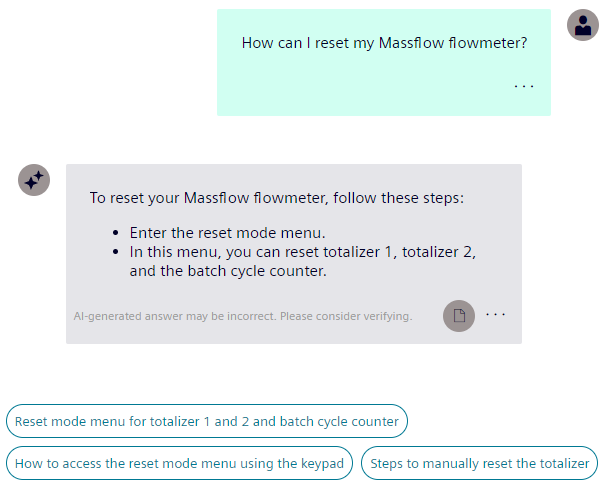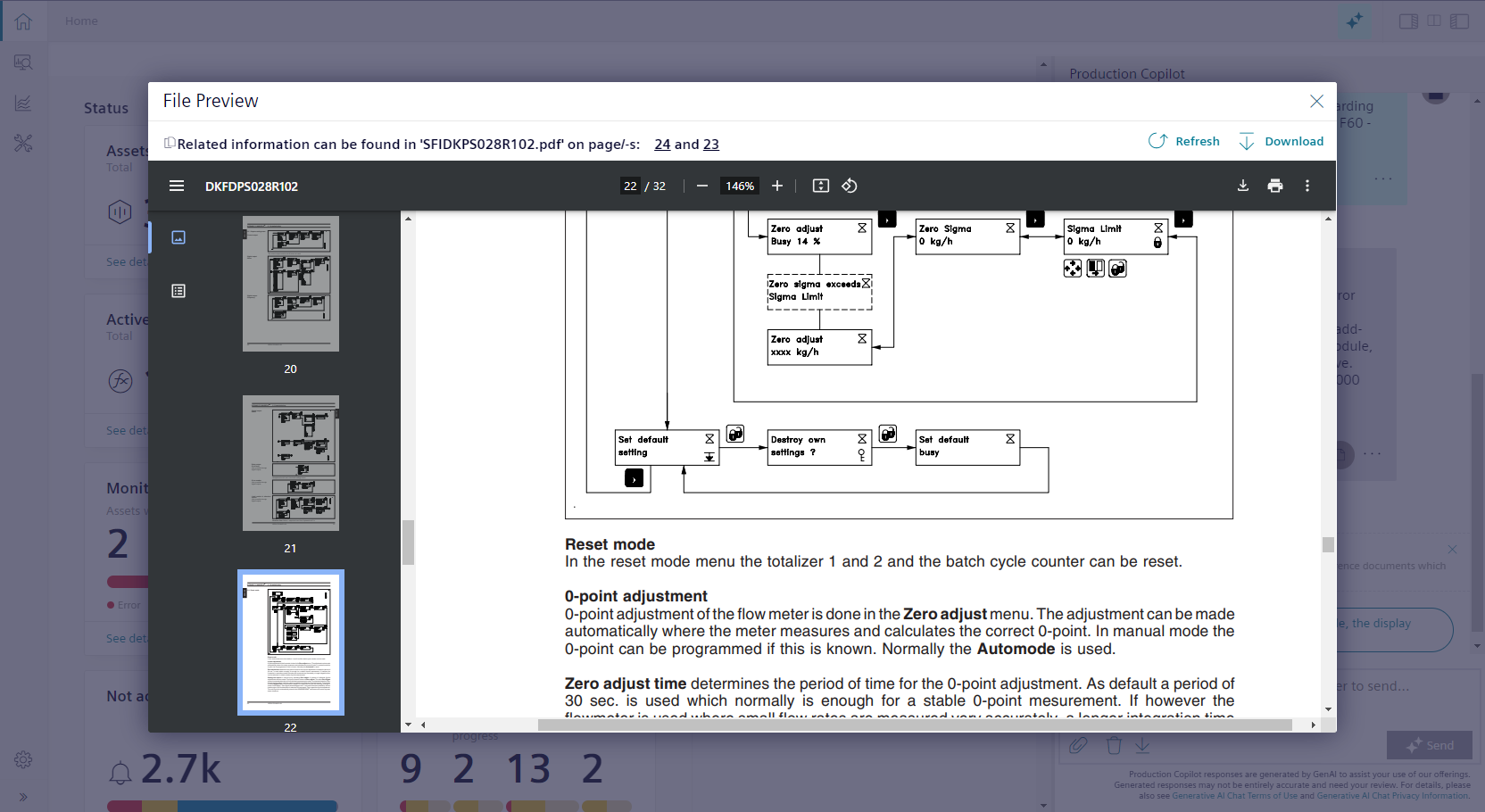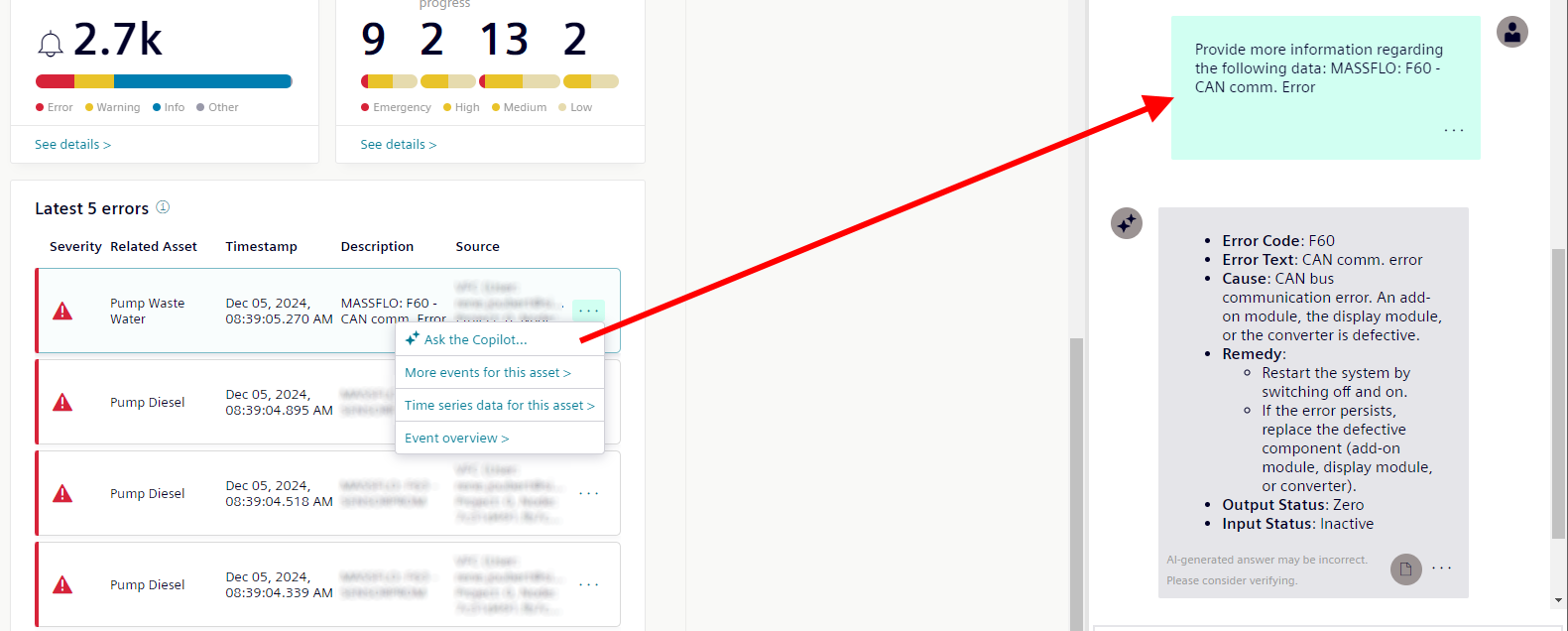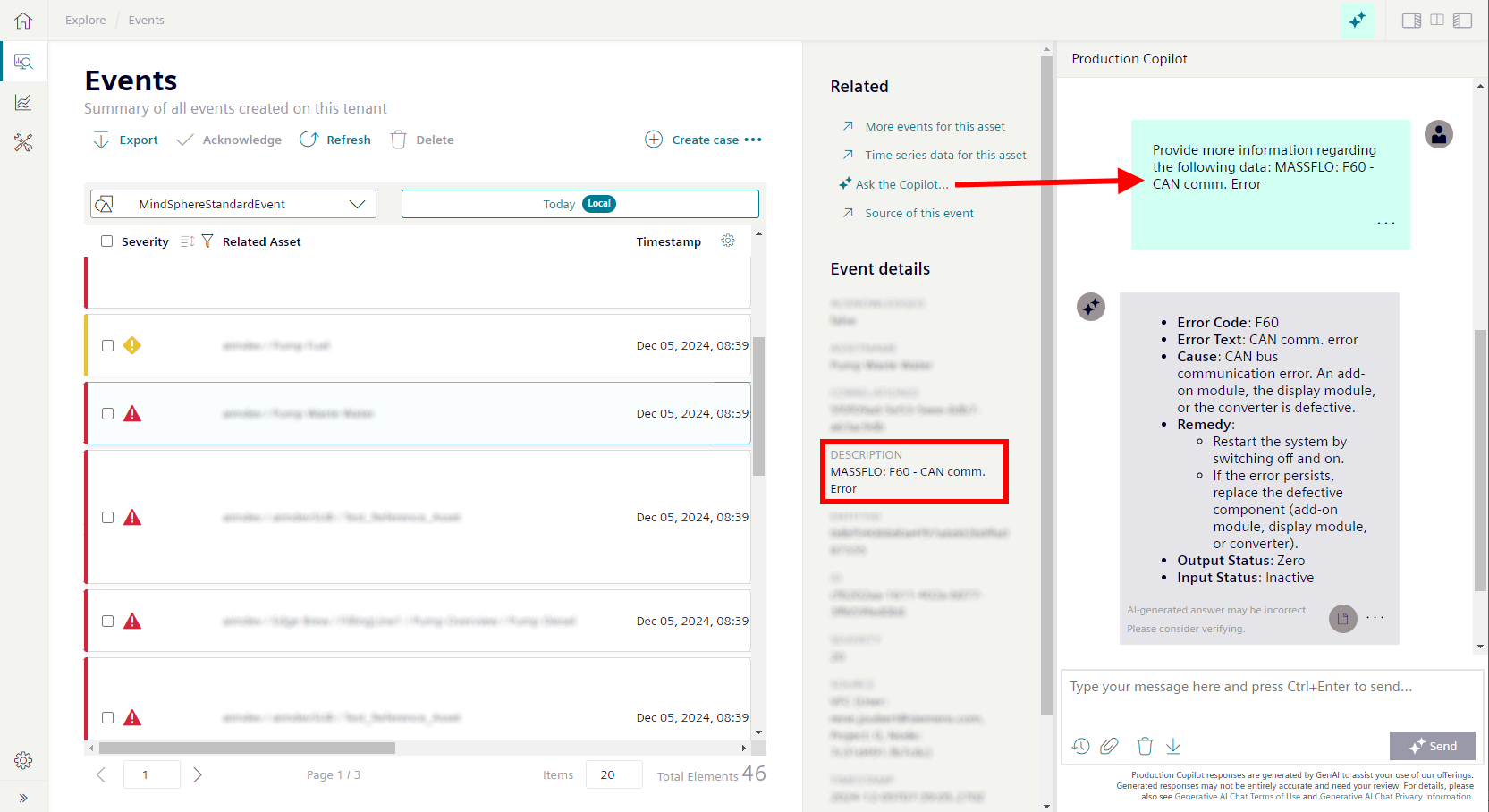Knowledge Base Agent¶
The Knowledge Base agent is the default agent, when you open Insights Hub Monitor. This prebuilt agent supports you searching content of specific files in Integrated Data Lake (IDL).
How it works¶
The chat interface can be opened via the dedicated button in the OS Bar:

The Production Copilot uses specific documents stored in the tenant's Integrated Data Lake (IDL). You can either upload a file to be used or tag specific files already stored there.
The Production Copilot uses these files with a large language model (LLM) to generate answers to your questions.
Users can see which files are in use and can add or delete files from the database.
Questions that do not relate to the user's documents cannot be answered.
The workflow from documents to an answer in the chat follows these steps:
- Upload files (if not already available).
- Tag files with
copilotin IDL. - Sync files, to add them to the Production Copilot's database.
- Ask related questions in the chat.

Inital steps¶
First of all, documents must be made available to the Production Copilot to answer any questions. Otherwise, the Copilot will answer somehow, that he has no files in his database.
There are two ways to get documents usable in the Production Copilot:
- Upload data using the chat interface.
- Reuse data already stored in IDL.
Upload data using the chat interface - the easy way¶
Files can be uploaded using the related button in the chat or simply by dragging and dropping a file into the chat window.
The file(s) will appear in the chat dialog and are ready to upload.

-
After confirming the upload, the document is:
- Uploaded to the
copilotfolder in IDL.
Please note the required policy ifResource Access Managementis active. - Automatically tagged with a
copilottag - Synced with the Production Copilot to be able to answer questions
Depending on the file size, this step can take some time.
- Uploaded to the
-
Finally, you will see a message that the document is processed and ready to work with

Reuse data already stored in IDL - the advanced way¶
If you have documents already stored in IDL, you can make them usable for the Production Copilot. Here, you have to do the steps manually, which were automatically done for you in the previous section.
To do this, you can tag all supported file types in IDL with a copilot tag:
-
Navigate to the specific file using IDL Manager and open the
Metadata Tagsview. Here, the tagcopilotshould be set.

-
Switch to Insights Hub Monitor and open the
Settingsmenu from the sidebar. Switch to the tabProduction Copilot

-
The new file is listed here with the status
Out of sync:

Sync files¶
In the Production Copilot settings, there are different ways to sync the files.
- Using the context menu of a single file, you can click on
Sync. Afterwards, the file is added to the Production Copilot's database and questions can be asked for this related file. - Furthermore, you can click on
Sync allin the table header to sync all files, which are currently not in sync. - Additionally, there is an option
Force syncin the table headers context menu, which additonally resets the tenants database before starting a new sync. - All
syncoperations can only be triggered by a Tenant Admin having the rolemdsp:core:TenantAdmin.
Initial sync duration
The duration of the initial sync may vary based on the number and size of the files. It is recommended to start the Sync all job overnight for optimal results.
In case a sync job temporarily fails, for instance due to rate limiting, you can initiate a single sync for the specific file at a later time.
Remove files¶
If you want to remove a file from the database, remove the copilot tag in IDL Manager. In Monitor "Settings", files are marked for deletion where the tag is no longer available. After clicking delete, the file is removed from the database, and the Production Copilot will not answer any related questions anymore.

Ask questions¶
When you ask a question related to an uploaded and synced document, production Copilot not only tries to answer the question, but it also generates related follow-up questions that a user can just click.

For optimal responses, provide detailed questions.
-
If Production Copilot answers a question related to a stored document, the answer shows a resource badge, where the best source for this answer can be checked out.
-
The document can be opened in a preview by clicking on the badge.
-
In the header of some file types also the page number is displayed.
The pages are ordered by their relevance.
Click on the document page to verify the answer in the document viewer.

-
If you accidentally deleted the chat or want to reuse a previous command, you can use the history button to select one of the last 10 questions.

-
For events, where you have might have stored the related documents, you can use the integrated buttons to ask questions regarding the event description.
In the following screens, users can select an event and ask Production Copilot for more information.- Home Screen
Use the context menu of the last 5 errors - Events overview
Select an event first - Assets > Events Select an event first
Click the
Ask the Copilotbutton. The Copilot chat window will open and use the event description for asking for more information.
 The Production Copilot will create a question using the event description.
The Production Copilot will create a question using the event description.The same functionality is also available in
Explore > Eventsas well as inExplore > Assets > Events. Select an event, and use the dedicated button. Also note that you need related documentation in sync.

- Home Screen
-
Finally you can provide feedback to the developers, by using the thumbs-up/-down button.

Ask for help¶
You can also ask this agent about the files synced withe the Knowledge Base or how to add a new file.
This can be helpful if you are not sure if specific files are already uploaded and synced.
FAQs and Best Practices¶
Questions Could Not Be Answered¶
In case your question cannot be answered, follow the next hints to improve:
- Did you check that a related file with useful content is uploaded to the system and synced with the Production Copilot?
Check the status of this file in the Production Copilot settings. - Is your question specific enough to find the right document?
Ask "What is the maintenance interval of my wastewater pump from manufacturer XYZ?" instead of only "What is the maintenance interval for my pump?" - Did you ask multiple questions regarding different topics in one conversation?
Start a new conversation to avoid polluting the chat history with other topics.
Handling of Data Contained in Long Tables¶
In case you want to provide documents with tabular data to the Production Copilot, consider the following:
- Production Copilot will perform a search based on keywords to determine if any of your documents contain relevant data for the user's question.
- For tabular data, the table header often contains relevant keywords - e.g., "Honing machine error code."
- Production Copilot will only consider document content that is in "local proximity" to the keyword. For the example above, error codes below the table header will be considered for the search.
- If you have a long table that spans multiple pages, make sure that the table header is repeated on each page. Otherwise, not all data will be considered by the Copilot.
One way of achieving this is as follows:
- Open your table in Excel.
- Select File > Print > Page Setup > Sheet.
- Go to the setting "Rows to repeat at top" and select the header area.
This will ensure that your table header shows up on each page. Check for correctness via print preview. Then export the page to PDF via File > Export, and upload the file as described above.